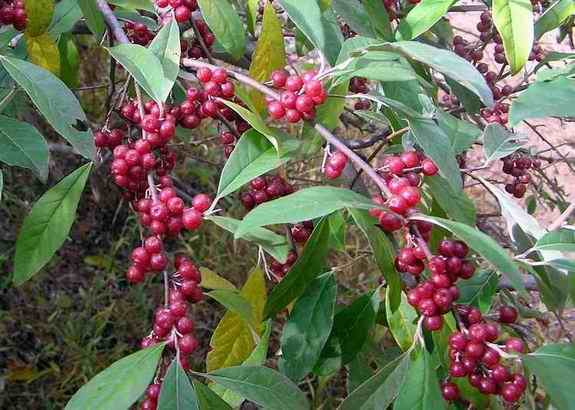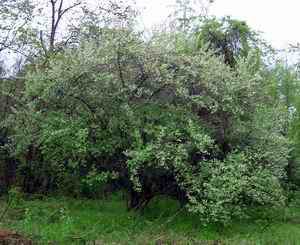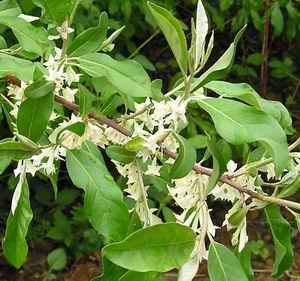|
Return to Hiker's Notebook Home Page
Common Name: Russian-olive, Autumn-olive, Oleaster - "Russian" refers to the one of the regions where the species is native. Autumn-Olive is a separate species, "autumn" referring to the time of year when the fruits ripen. Both are hyphenated to indicate that they are not true olives. Oleaster is the predominant name in Eurasia, deriving from the Latin olea meaning olive due to the olive-like appearance of the fruit.
Scientific Name: Elaeagnus angustifolia - The generic name is
from the Greek elaia which means olive and agnos which is the
name of a tree that has the same leaf shape (Vitus agnus-castus) in its
native Eurasia. Angusto is the Latin word for "narrow" and folium
is the Latin word for "leaf;" hence, having narrow leaves. Autumn-olive is
Elaeagnus umbellata, the species name is a diminutive form of
the Latin umbella which means parasol (umbra is Latin for shade so the
umbrella is a combination form) and refers to the umbel configuration of the
flowers, clustered at a central point with stems of equal length like the
spokes of an umbrella.
Russian-olive and Autumn-olive are classified as invasive species in most areas. Both are small, somewhat thorny shrubs or small trees that are characterized by silvery scales that cover new growth stems, the leaves, the flowers and the fruit. The silvery highlights of the undersides of the leaves of both species cast a readily identifiable gray-green hue to the trees when seen from a distance.
The Russian-olive is native to an area extending from southern Europe to western and central Asia. Its wide geographic range from the Mediterranean to northern Russia encompasses many different environments, testimony to the high adaptability of the tree. It was first cultivated in Germany as the Oleaster in 1736 and brought to North America in the 19th Century for use as a windbreak and as a livestock hedge on the western prairies. Some of the early trees were imported from southern Europe and did not stand up to the harsher weather of North America. The Mennonites are generally credited with the introduction of hardier trees from Russia that were cold tolerant; the name Russian-olive eventually being used as an indication of this origin. The Russian-olive was subsequently planted as an ornamental throughout the United States and became one of the most popular trees sold by nurseries between 1980 and 1986. . As recently as the 1990's Russian-olive seedlings were subsidized by state and federal agencies in the western United States to reduce soil erosion in open areas.
The Autumn-olive is a native of East Asia, notably Japan, China and Korea. It was introduced into the United States in the 1830's primarily for revegetation of disturbed areas. It was evaluated by the Soil Conservation Service in the 1940's and a new strain known as 'Cardinal' was released in 1963 for commercial propagation. In addition to providing windbreak screening and barrier protection along highways, the autumn-olive was also touted as a means to stabilize and revegetate disturbed areas, to reclaim mine spoil, and to provide food and cover for wildlife, a seeming panacea. As late as 1975, it was characterized as rarely escaping cultivation.
The invasive spread of the Russian-olive and the Autumn-olive is attributable to a number of factors. They produce a large number of long-lived seeds many of which are viable for propagation. Over fifty species of birds and mammals consume the fruit of the trees which results in extensive dispersion of the seeds. While this can be beneficial to the animals that consume the fruits of the tree, it can be detrimental to others; the trees supplant native species such as cottonwood and willow that serve as nesting sites and insect sources for some birds. It is estimated that a third of riparian bird species are negatively impacted by habitat loss attributable to Russian-olive. The roots of Russian-olive and Autumn-olive contain nitrogen-fixing nodules that promote growth even in dry and infertile soils, making them particularly well suited to disturbed areas. They are resistant to ocean salt spray and windblown sand, making them ideal for coastal areas |


 The
Russian-olive and the Autumn-olive are very similar in appearance, and
distinguishing them requires close inspection. The Russian-olive usually has
small thorns along the smaller branches and relatively narrow lanceolate
leaves. The flowers are creamy yellow and the fruits are silvery yellow or
orange. The Autumn-olive is less likely to have thorns and has leaves that are
more elliptical or oval than those of the Russian-olive. The flowers are a
lighter shade of yellow (left) and the abundant fruits range in color from
pink to red (top).
The
Russian-olive and the Autumn-olive are very similar in appearance, and
distinguishing them requires close inspection. The Russian-olive usually has
small thorns along the smaller branches and relatively narrow lanceolate
leaves. The flowers are creamy yellow and the fruits are silvery yellow or
orange. The Autumn-olive is less likely to have thorns and has leaves that are
more elliptical or oval than those of the Russian-olive. The flowers are a
lighter shade of yellow (left) and the abundant fruits range in color from
pink to red (top).